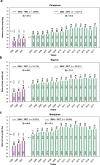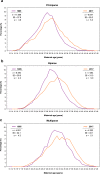Obesity in pregnant women: a 20-year analysis of the German experience
- PMID: 34702964
- PMCID: PMC8636254
- DOI: 10.1038/s41430-021-00981-8
Obesity in pregnant women: a 20-year analysis of the German experience
Abstract
Background/objective: To investigate the longitudinal development of maternal body weight and analyze the influence of obesity on obstetrics during more than two decades in Germany.
Subjects/methods: Data collected from the Federal state of Schleswig-Holstein (German Perinatal Survey) were analyzed with regard to the dynamics of maternal anthropometric variables (body weight, BMI) between 1995-7 and 2004-17. In total 335,511 mothers substantiated the presented study-collective. The statistical analysis was performed using IBM SPSS Statistics for Windows, Version 26.0. Armonk, NY.
Results: Maternal BMI advanced significantly over the study period. Among a rise in mean periconceptional body weight (67.6-72.0 kg), the segment of obese women increased disproportionately (in average 9.4-19.2%). Despite the observed trend to late giving birth (mean maternal age 1995: 29.3 vs. 30.7 years in 2017), it was not advanced maternal age but parity that influenced the continuous increase in maternal weight (mean maternal body weight 1995-7: primi- bi-, multiparae 67.4, 68.3 and 69.0 kg vs. 2004-17: primi- bi-, multiparae 70.0, 71.5 and 73.2 kg respectively).
Conclusion: Obesity is a major problem on health issues in obstetrics. Advancing maternal BMI, increasing mother's age and derived prenatal risks considerably complicate pregnancy and delivery. It has to be emphasized that its consequences do not end with delivery or childbed, but represent a livelong burden to the mother and their offspring. Hence, multimodal strategies to reduce/control periconceptional body weight are mandatory.
© 2021. The Author(s).
Conflict of interest statement
The authors declare no competing interests.
Figures




Similar articles
-
Late-pregnancy dysglycemia in obese pregnancies after negative testing for gestational diabetes and risk of future childhood overweight: An interim analysis from a longitudinal mother-child cohort study.PLoS Med. 2018 Oct 29;15(10):e1002681. doi: 10.1371/journal.pmed.1002681. eCollection 2018 Oct. PLoS Med. 2018. PMID: 30372451 Free PMC article.
-
Offspring body size and metabolic profile - effects of lifestyle intervention in obese pregnant women.Dan Med J. 2014 Jul;61(7):B4893. Dan Med J. 2014. PMID: 25123127 Review.
-
The importance of maternal BMI on infant's birth weight in four BMI groups for the period 1978-2001.Acta Obstet Gynecol Scand. 2009;88(4):391-6. doi: 10.1080/00016340902807199. Acta Obstet Gynecol Scand. 2009. PMID: 19266360
-
The effect of weight management interventions that include a diet component on weight-related outcomes in pregnant and postpartum women: a systematic review protocol.JBI Database System Rev Implement Rep. 2015 Jan;13(1):88-98. doi: 10.11124/jbisrir-2015-1812. JBI Database System Rev Implement Rep. 2015. PMID: 26447010
-
The cumulative impact of parity on the body mass index (BMI) in a non-selected Lower Saxony population.J Perinat Med. 2020 Dec 1;49(4):460-467. doi: 10.1515/jpm-2020-0261. Print 2021 May 26. J Perinat Med. 2020. PMID: 33554575
Cited by
-
Development and validation of a screening questionnaire for early identification of pregnant women at risk for excessive gestational weight gain.BMC Pregnancy Childbirth. 2023 Apr 13;23(1):249. doi: 10.1186/s12884-023-05569-7. BMC Pregnancy Childbirth. 2023. PMID: 37055730 Free PMC article.
-
Effects of pre-pregnancy BMI and gestational weight gain on pregnancy and neonatal outcomes in Poland.Sci Rep. 2025 Mar 4;15(1):7603. doi: 10.1038/s41598-025-91879-z. Sci Rep. 2025. PMID: 40038348 Free PMC article.
-
Obesity in prenatal medicine: a game changer?Arch Gynecol Obstet. 2024 Mar;309(3):961-974. doi: 10.1007/s00404-023-07251-x. Epub 2023 Oct 20. Arch Gynecol Obstet. 2024. PMID: 37861742 Free PMC article. Review.
-
Kidney disease and reproductive health.Nat Rev Nephrol. 2025 Feb;21(2):127-143. doi: 10.1038/s41581-024-00901-6. Epub 2024 Nov 5. Nat Rev Nephrol. 2025. PMID: 39501029 Review.
-
Performance of sFlt-1/PIGF Ratio for the Prediction of Perinatal Outcome in Obese Pre-Eclamptic Women.J Clin Med. 2022 May 27;11(11):3023. doi: 10.3390/jcm11113023. J Clin Med. 2022. PMID: 35683415 Free PMC article.
References
-
- Robert Koch-Institut (RKI). AdiMon-Themenblatt Schwangerschaft. 2018; https://www.rki.de/DE/Content/Gesundheitsmonitoring/Studien/Adipositas_M....
MeSH terms
LinkOut - more resources
Full Text Sources
Medical

